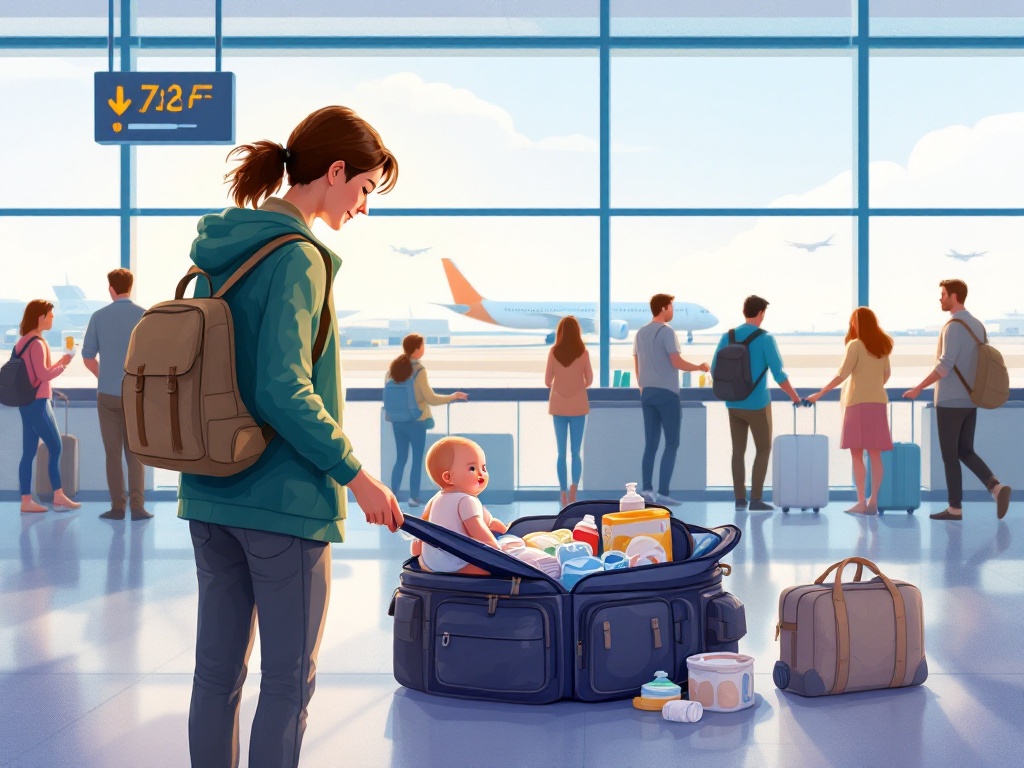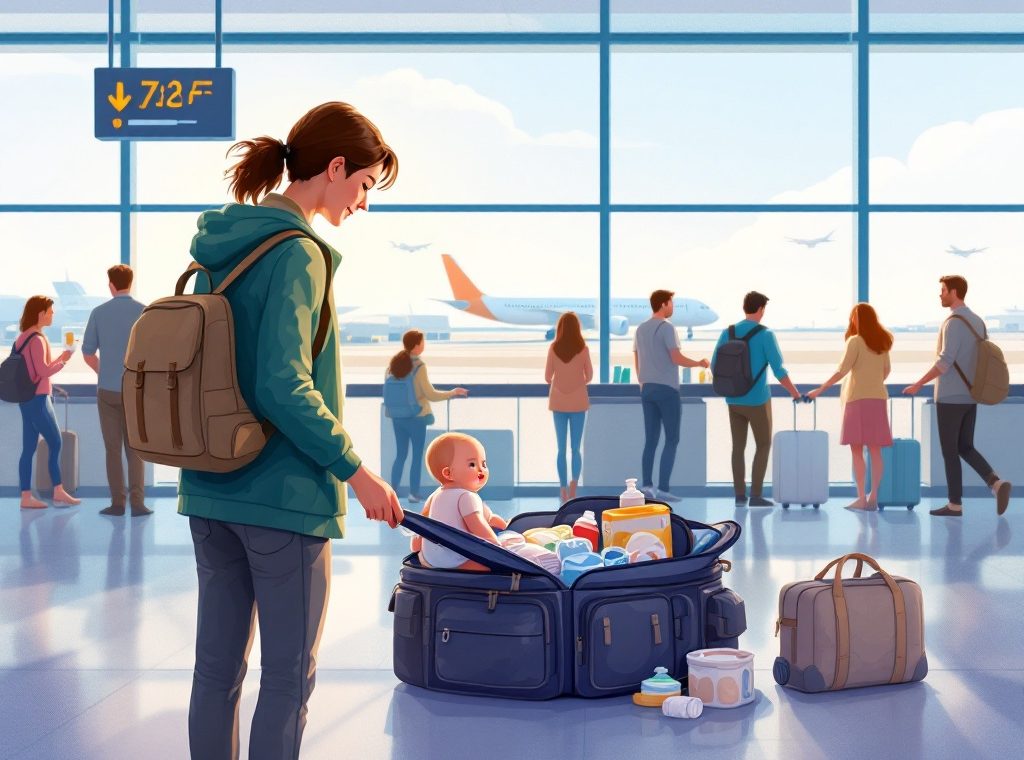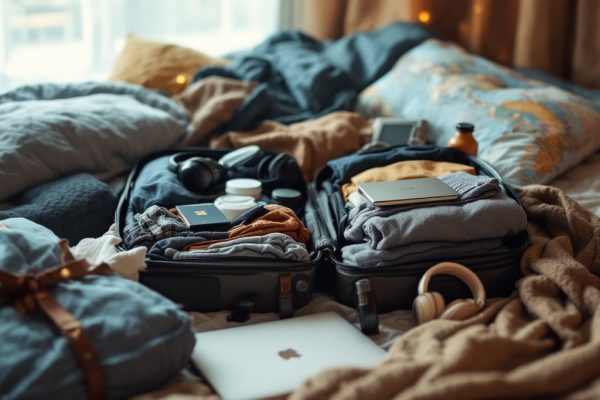Essential Packing Tips for Traveling with an Infant by Plane
Planning your first flight with a baby? Discover essential tips for a smooth journey! Learn how choosing the right flight time and seat can maximize your infant’s comfort. We’ll guide you through packing the perfect diaper bag, navigating airline policies, and ensuring your baby’s health and safety. Prepare for takeoff with confidence and make your family’s air travel experience enjoyable!
Important information

- Check your airline’s specific policies on infant travel, including fees, baggage allowance, and requirements for bassinets or car seats.
- Book flights in advance, considering your baby’s sleep schedule and selecting bulkhead seats (for bassinets) or aisle seats (for easier access).
- Pack essential gear: a car seat (if allowed), stroller (gate-check option), or baby carrier for airport navigation and in-flight comfort. Bring a well-stocked diaper bag with diapers, wipes, changing pad, extra clothes, rash cream, and hand sanitizer.
- Prepare for feeding: Breastfeeding mothers should dress comfortably and consider a nursing cover. Formula-feeding parents should pre-measure formula and bring extra. For babies eating solids, pack non-messy snacks, bib, and spoon. TSA allows formula, breast milk, and baby food beyond the standard liquid limit.
- Ensure infant comfort: Address ear pressure changes during takeoff and landing by offering a pacifier, bottle, or breastfeeding. Pack familiar items for sleep and entertainment.
Preparing for Air Travel with an Infant
Traveling with a baby requires careful planning. Review the airline’s policies on age limits, tickets, and baggage, as some restrict infant travel or have specific regulations. Booking flights in advance can secure a bulkhead seat with a bassinet or an aisle seat for easier access. Consider your baby’s sleep schedule when choosing flight times for a smoother journey.
Understanding Airline Policies for Infants
Traveling with an infant under two years old often allows them to fly on your lap, but keep in mind there’s usually a fee involved. For international flights, some airlines might require a separate ticket for your baby. Always check your airline’s specific policies regarding infants before booking your flight. Be aware that additional charges may apply for bassinets or other infant necessities.
Choosing the Right Time to Fly
To ensure a smoother flight, consider booking one that aligns with your baby’s sleep schedule. Early morning or late evening departures are often ideal, as longer journeys can be surprisingly easier if they coincide with your baby’s sleep rhythm. Remember to keep your little one’s sleep patterns in mind when planning your trip.
Booking Seats and Accommodations
Secure your preferred seat by booking early. Bulkhead seats provide extra legroom, which is especially advantageous for taller passengers. For those traveling with infants on long flights, bassinets might be available, but remember that weight and length restrictions apply. Contact your airline to verify bassinet dimensions and availability, as well as any specific requirements for infants.
Essential Baby Gear for Air Travel
Traveling with a baby can be much easier with the right gear. A car seat is essential for car travel and can provide a familiar comfort zone during flights. Be sure to check your airline’s specific car seat policy. For navigating bustling airports and lengthy layovers, a stroller is invaluable, especially with the gate-checking option many airlines provide. Alternatively, a baby carrier keeps your little one snug and close while freeing up your hands. If you have space, bringing both a stroller and carrier offers the best of both worlds – convenient mobility and close contact with your baby.
Choosing an Appropriate Car Seat
For your child’s safety during air travel, choose an FAA-approved car seat. Consider a lighter, more compact model for easier installation and a smoother travel experience.
Stroller Options for Air Travel
Traveling with young children can be effortless with a lightweight stroller. Gate-checking a compact model simplifies airport navigation. Consider these options:
- Easy-to-fold umbrella strollers,
- Convenient travel systems,
- Other compact folding designs.
While these strollers prioritize portability, remember to check your airline’s size and weight restrictions before your trip to avoid surprises.
Baby Carrier vs. Stroller: Which is Better?
Baby carriers are ideal for navigating busy airports and planes, allowing hands-free movement while keeping your little one close.
Strollers offer a familiar comfort zone for babies and valuable extra storage for parents.
Consider your individual needs and the specific airport layout to determine the best choice for your family’s travel.
Clothing and Diaper Essentials for Infants
Pack layered clothing to easily adapt to fluctuating temperatures, as weather can change unexpectedly while traveling. Extra clothes are essential for handling spills or unforeseen mishaps. If you are traveling with a baby, ensure you have an ample supply of diapers for the entire trip, along with extras for emergencies. Don’t forget wipes, diaper rash cream, and disposable diaper bags for easy cleanup.
Packing the Right Clothing for Different Climates
Dressing your baby in layers makes adjusting to temperature changes easier. Pack lightweight, easy-to-change clothing. Consider the weather at both your origin and destination.
For Warm Climates
Breathable fabrics like cotton are ideal.
For Cold Climates
Pack warm layers such as fleece or wool. Essentials like hats, socks, and mittens are a must. Even in warm destinations, a light jacket or sweater is recommended, as airplane cabins can get quite cold.
Diaper Bag Essentials for a Flight
Traveling with a baby? Pack these essentials for a smoother flight:
- diapers,
- wipes,
- a changing pad,
- a change of clothes,
- diaper rash cream,
- plastic bags for soiled diapers,
- hand sanitizer.
Feeding Your Infant During the Flight
Traveling with a baby? Here are some helpful tips for a smoother flight:
For Breastfeeding Mothers
- To help equalize your baby’s ear pressure during takeoff and landing, try breastfeeding, it will help to relieve the pressure.
- Dress comfortably and consider using a nursing cover for added privacy.
- An aisle seat will provide you with more space and easier access to the restroom.
For Formula-Feeding Parents
- Pre-measure formula into bottles or a dispenser for convenient feeding during the flight.
- Ensure you have enough water and pack extra formula to account for any unexpected delays.
- Ready-to-feed formula is a convenient option that requires no mixing.
- Formula, breast milk, and baby food are permitted through security beyond the standard 3.4-ounce liquid limit; simply inform the TSA agent.
For Babies Eating Solids
- Pack manageable, non-messy snacks such as puffs, soft fruits, or pre-cut vegetables.
- Remember to bring a bib and spoon for feeding.
Breastfeeding Tips on a Plane
Discreetly breastfeeding on a plane is possible with a nursing cover. Booking flights during less busy periods can also make feeding more comfortable.
Formula Feeding: What to Bring
Pack ample formula for your trip, plus some extra to account for potential delays. Pre-measured portions in travel containers offer convenient preparation. Alternatively, ready-to-feed bottles simplify feeding during your flight.
Handling Solids and Snacks
When packing for a baby already enjoying solid foods, opt for convenient and mess-free options. Consider the baby’s dietary needs and preferences, such as purees, puffs, or soft fruits.
Keeping Your Infant Comfortable During the Flight
To help your baby’s ears adjust during takeoff and landing, offer a pacifier or a feeding. This encourages swallowing, which helps equalize ear pressure.
A familiar blanket or toy can create a comforting sleep environment for your baby on the flight. Maintaining their usual sleep schedule and using a baby carrier can also help them rest peacefully.
To keep your little one entertained, pack new toys, books, or try simple games like peek-a-boo. Singing can also soothe them. Older infants might enjoy soft toys or teethers.
Managing Ear Pressure Changes
Changes in cabin pressure during air travel can often cause discomfort for babies. Offering a pacifier, bottle, or breastfeeding during takeoff and landing helps them equalize ear pressure. Even simple actions like yawning or swallowing can provide relief and improve their comfort.
Ensuring Proper Sleep on the Plane
Pack familiar blankets and comforting toys to create a cozy, familiar sleep environment.
Time naps with the flight to maximize sleep.
A bassinet, if available, offers a dedicated sleep space.
For a restless baby, try a walk down the aisle or some quiet activities.
Entertainment Options for Infants
- Soft toys and rattles offer comfort and distraction.
- Teethers soothe sore gums.
- Board books provide quiet entertainment.
- Electronic devices (if allowed) with pre-loaded lullabies and nursery rhymes can be calming.
- Interactive tablet games offer visual stimulation for older babies.
Health and Safety Considerations
Your baby’s travel first-aid kit should include: a thermometer, pain reliever, nasal aspirator, antiseptic wipes, and bandages. Also, remember any prescribed medications.
Maintain a clean environment throughout your flight. Sanitize surfaces like tray tables and armrests often, and use hand sanitizer regularly, especially after diaper changes and before meals.
Pack ample wipes and sanitizer to last the entire journey.
Infant First Aid Kit Essentials
Pack a well-stocked first aid kit for your baby’s flight. Include band-aids for minor cuts and scrapes, antiseptic wipes to clean wounds, and any essential prescribed medications. Be sure to check the airline’s regulations on permitted medications and required documentation.
Sanitizing and Hygiene Tips
Frequently clean tray tables, armrests, and seat buckles with sanitizing wipes.
Regular handwashing with soap and water is crucial, but hand sanitizer is also a good option, especially after restroom visits and before meals or feeding a child.
These practices help prevent the spread of germs and reduce your risk of illness.














